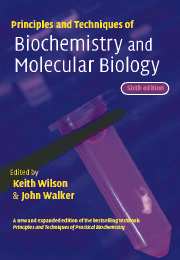Book contents
- Frontmatter
- Contents
- Preface to the sixth edition
- List of contributors
- List of abbreviations
- 1 Basic principles
- 2 Cell culture techniques
- 3 Centrifugation
- 4 Microscopy
- 5 Molecular biology, bioinformatics and basic techniques
- 6 Recombinant DNA and genetic analysis
- 7 Immunochemical techniques
- 8 Protein structure, purification, characterisation and function analysis
- 9 Mass spectrometric techniques
- 10 Electrophoretic techniques
- 11 Chromatographic techniques
- 12 Spectroscopic techniques: I Atomic and molecular electronic spectroscopy
- 13 Spectroscopic techniques: II Vibrational spectroscopy and electron and nuclear spin orientation in magnetic fields
- 14 Radioisotope techniques
- 15 Enzymes
- 16 Cell membrane receptors
- Index
- Plate sections
15 - Enzymes
Published online by Cambridge University Press: 05 June 2012
- Frontmatter
- Contents
- Preface to the sixth edition
- List of contributors
- List of abbreviations
- 1 Basic principles
- 2 Cell culture techniques
- 3 Centrifugation
- 4 Microscopy
- 5 Molecular biology, bioinformatics and basic techniques
- 6 Recombinant DNA and genetic analysis
- 7 Immunochemical techniques
- 8 Protein structure, purification, characterisation and function analysis
- 9 Mass spectrometric techniques
- 10 Electrophoretic techniques
- 11 Chromatographic techniques
- 12 Spectroscopic techniques: I Atomic and molecular electronic spectroscopy
- 13 Spectroscopic techniques: II Vibrational spectroscopy and electron and nuclear spin orientation in magnetic fields
- 14 Radioisotope techniques
- 15 Enzymes
- 16 Cell membrane receptors
- Index
- Plate sections
Summary
CHARACTERISTICS AND NOMENCLATURE
Enzymes are single- or multiple-chain proteins that act as biological catalysts with the ability to promote specific chemical reactions under the mild conditions that prevail in most living organisms. They have three distinctive characteristics:
Specificity: Enzymes show a characteristic specificity for the reaction they promote and the substrates they can use. As a generalisation, anabolic enzymes show a higher specificity than catabolic ones. Bond specificity is characteristic of enzymes such as the peptidases and esterases that hydrolyse specific bond types. The specificity of these enzymes is determined by the presence of specific functional groups adjacent to the bond to be cleaved. Group specificity is characteristic of enzymes that promote a particular reaction on a structurally related group of substrates. As an example, the kinases catalyse the phosphorylation of substrates that have a common structural feature such as a particular amino acid (e.g. the tyrosine kinases) or sugar (e.g. hexokinase). Absolute or near-absolute specificity is characteristic of anabolic enzymes that catalyse one specific reaction. Enzymes may also display stereospecificity and be able to distinguish between optical and geometrical isomers of substrates or, in the case of the NAD+- or NADP+-requiring dehydrogenases, to distinguish between apparently identical hydrogen atoms located on opposite sides of the nicotinamide ring (see Section 15.4.4).
High catalytic rate: Enzymes enhance the reaction rate by factors as high as 1012 relative to the non-enzyme-catalysed reaction. […]
- Type
- Chapter
- Information
- Principles and Techniques of Biochemistry and Molecular Biology , pp. 665 - 718Publisher: Cambridge University PressPrint publication year: 2005



